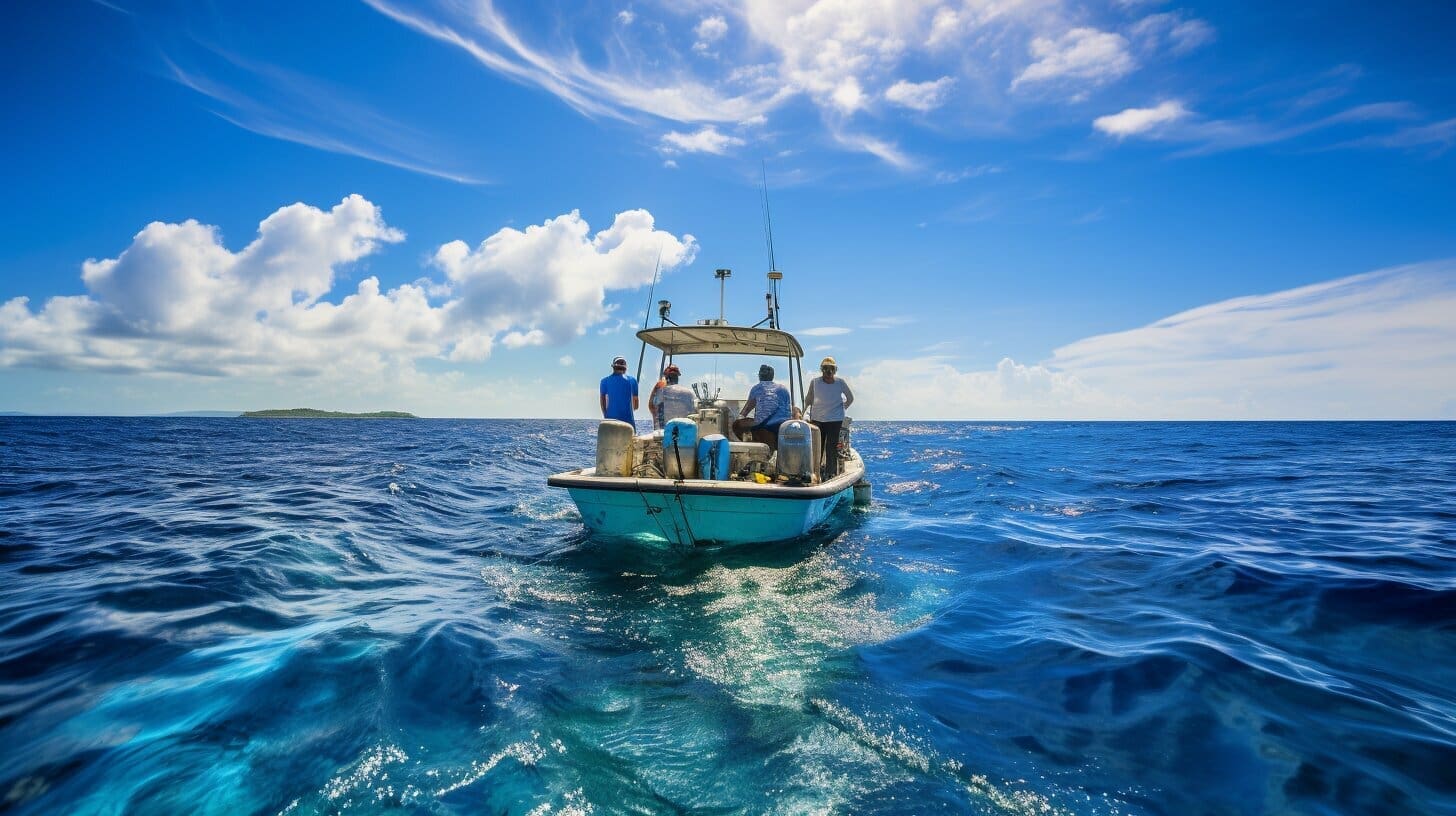Are you ready to embark on an exhilarating adventure that will take you to the depths of the ocean? Look no further than deep sea fishing! Whether you’re an experienced angler or a beginner, deep sea fishing offers the perfect combination of excitement and challenge. Get ready to reel in big catches like tuna, marlin, and mahi-mahi while immersing yourself in the beauty of the open sea.
If you’re wondering where to start, we’ve got you covered. In this guide, we’ll take you through the top destinations for deep sea fishing, share tips and techniques to increase your chances of success, and highlight the essential equipment you’ll need. Whether you’re looking for deep sea fishing near you or planning a vacation to popular destinations like Destin, Panama City Beach, Myrtle Beach, or Galveston, we’ve got all the information you need to make your deep sea fishing experience unforgettable.
Key Takeaways:
- Deep sea fishing offers an exciting and challenging adventure for anglers of all levels.
- Top deep sea fishing destinations include Destin, Panama City Beach, Myrtle Beach, and Galveston.
- Pay attention to the essential equipment needed for a successful deep sea fishing trip.
- Follow the tips and techniques shared in this guide to increase your chances of catching big game fish.
- Always prioritize safety and adhere to fishing regulations to protect the environment and fish populations.
Top Locations for Deep Sea Fishing
When it comes to deep sea fishing, certain locations stand out as prime destinations for anglers. One such location is Murrells Inlet, situated on the coast of South Carolina. This charming fishing village offers a wealth of opportunities for a fruitful fishing excursion. Another notable spot is the Georgetown Hole, a deep sea trench that attracts a wide range of fish species, including tuna, marlin, and swordfish. The Winyah Scarp, a steep underwater cliff, is also renowned for its large schools of mahi-mahi and wahoo. Lastly, the Black Jack Hole, located just a few miles offshore, is known for its abundant king mackerel, black sea bass, and grouper.
Whether you choose to cast your line in Murrells Inlet or explore other locations, it’s essential to consult with local experts or charter companies to gain insight into the best spots and techniques for a successful fishing trip.
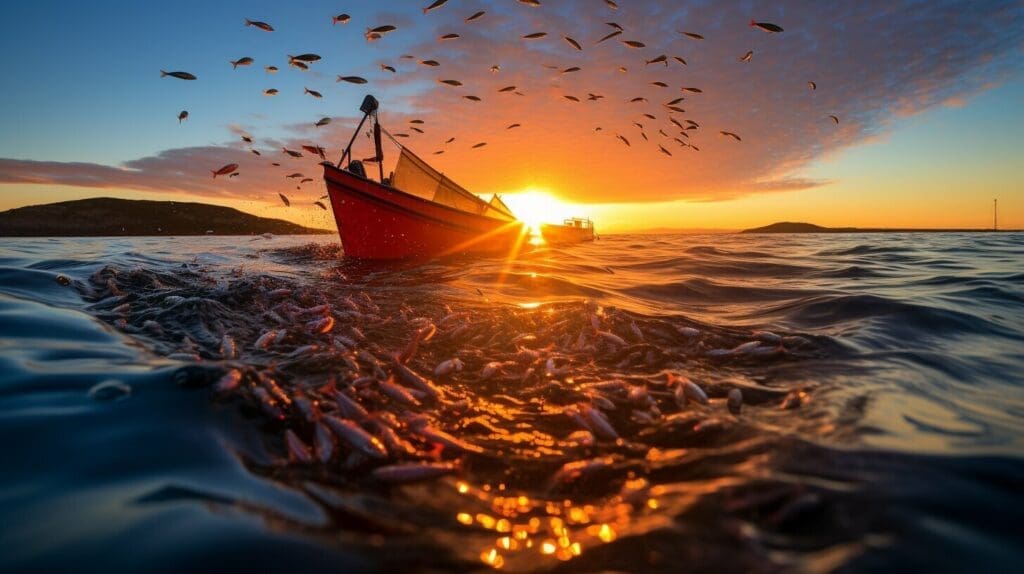
Table: Top Locations for Deep Sea Fishing
| Location | Fish Species |
|---|---|
| Murrells Inlet, South Carolina | Tuna, Marlin, Mahi-Mahi, Wahoo |
| Georgetown Hole | Tuna, Marlin, Swordfish |
| Winyah Scarp | Mahi-Mahi, Wahoo |
| Black Jack Hole | King Mackerel, Black Sea Bass, Grouper |
Whether you’re a seasoned angler or new to deep sea fishing, venturing to these top locations will provide an exhilarating experience as you cast your line into the depths and await the thrill of a big catch.
Catching Fish in Murrells Inlet
While deep sea fishing in Murrells Inlet, you’ll have the opportunity to catch a variety of fish species that inhabit the waters. Some of the popular catches include red snapper, grouper, and mahi-mahi. Red snapper can be found near structures like wrecks or reefs and are commonly caught using live bait. Grouper, on the other hand, can be targeted near the bottom of the ocean using both live and artificial bait. These fish are known for their size and strength, providing an exciting challenge for anglers.
Mahi-mahi, also known as dorado or dolphinfish, are highly sought-after in Murrells Inlet. These vibrant and acrobatic fish can be targeted using live bait like squid or ballyhoo. Tuna, wahoo, and marlin are also species that you may encounter during your deep sea fishing adventure. These fish are known for their impressive fighting abilities, making for an exhilarating angling experience.
Common Fish Species in Murrells Inlet
- Red Snapper
- Grouper
- Mahi-Mahi
- Tuna
- Wahoo
- Marlin
Whether you’re targeting red snapper, grouper, mahi-mahi, or any other species, it’s important to come prepared with the right equipment and techniques. The knowledgeable captains and crews of local charter services can provide guidance on the best fishing spots and methods for maximizing your chances of success. So grab your gear, head out to Murrells Inlet, and get ready for an exciting deep sea fishing experience filled with thrilling catches.
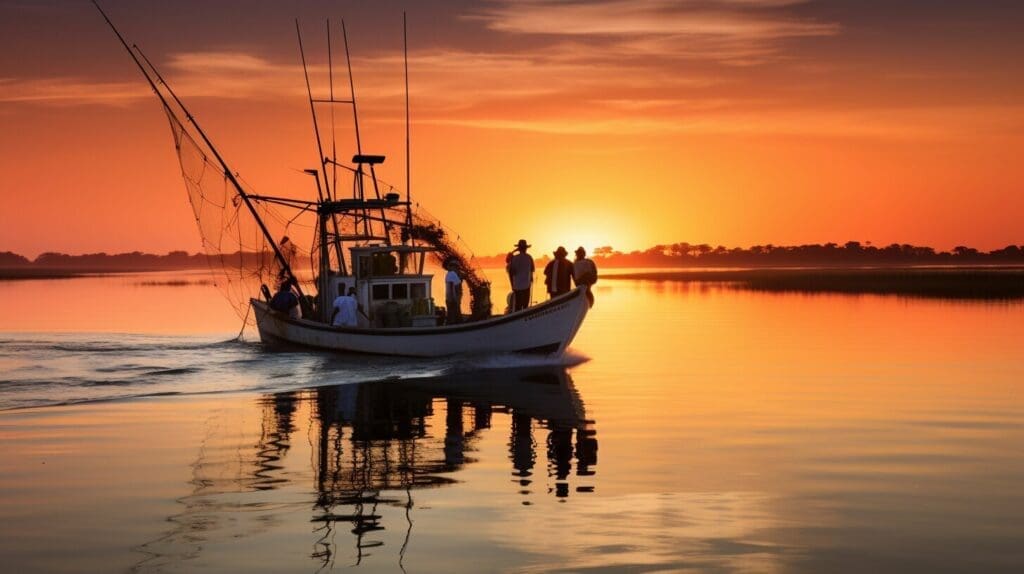
| Fish Species | Best Techniques | Preferred Bait |
|---|---|---|
| Red Snapper | Near structures like wrecks or reefs | Live bait |
| Grouper | Near the bottom of the ocean | Live and artificial bait |
| Mahi-Mahi | Open waters, near floating debris | Live bait (squid, ballyhoo) |
| Tuna | Pelagic waters, near offshore structures | Live bait, artificial lures |
| Wahoo | Pelagic waters, near offshore structures | Live bait, artificial lures |
| Marlin | Deep waters, near drop-offs | Live bait, artificial lures |
Essential Equipment for Deep Sea Fishing
When embarking on a deep sea fishing adventure, having the right equipment is essential for a successful and enjoyable experience. Here are some key items you’ll need:
Rods and Reels
Your choice of rods and reels should be strong and durable, capable of handling the weight and strength of big game fish like tuna and marlin. Look for quality equipment that is designed for deep sea fishing.
Fishing Lines
Invest in high-quality fishing lines that can withstand the force and tension of battling with large fish. Braided lines are a popular choice for deep sea fishing due to their strength and sensitivity.
Bait and Lures
When it comes to bait and lures, it’s important to have a variety of options to attract different fish species. Research the type of fish you want to catch and stock up on suitable bait and lures. Live bait, such as squid or ballyhoo, is often effective for deep sea fishing.
Boat or Charter Service
To access the deep waters where the big catches are found, you’ll need a boat or a charter service. If you have your own boat, ensure it is properly equipped for deep sea fishing. Alternatively, hiring a charter service provides access to experienced captains and crew who know the best fishing spots and techniques.
| Item | Description |
|---|---|
| Rods and Reels | Strong and durable equipment designed for deep sea fishing |
| Fishing Lines | High-quality lines that can withstand the force of large fish |
| Bait and Lures | A variety of options to attract different fish species |
| Boat or Charter Service | Access to deep waters and experienced captains |
Having the right equipment increases your chances of success and ensures you’re well-prepared for the challenges of deep sea fishing. Whether you’re a seasoned angler or a beginner, investing in quality rods, reels, lines, bait, and a reliable boat or charter service will help you make the most of your deep sea fishing adventure.
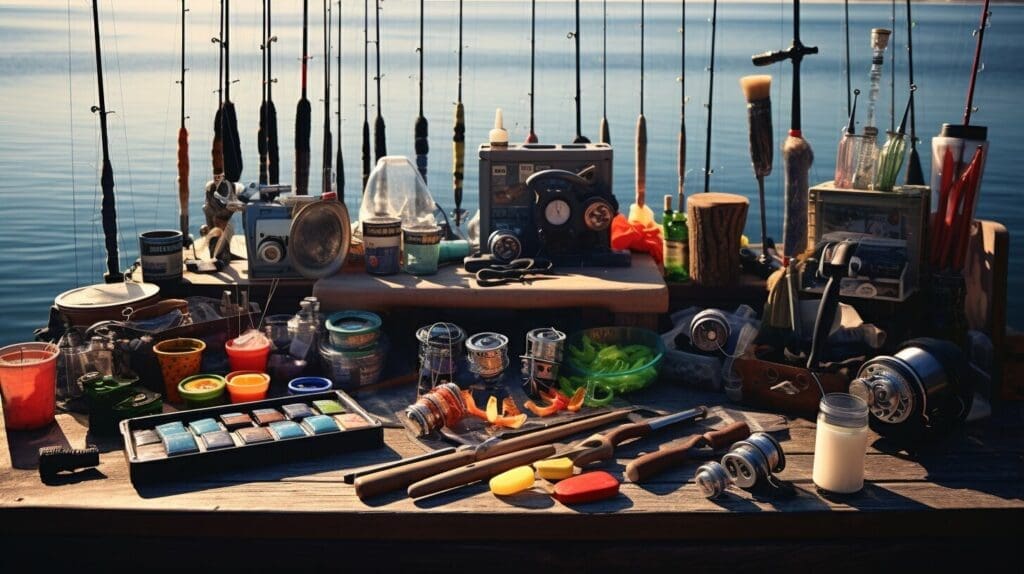
Tips for Catching Trophy Fish
To increase your chances of catching a trophy fish during deep sea fishing, it’s important to have a strong and durable rod and reel that can handle the fight of a large fish. A high-quality fishing line that can withstand the weight and strength of big game fish is also crucial. Experimenting with various baits and lures can help you determine what works best for the species you’re targeting. Having the right equipment increases your chances of success and allows for a more enjoyable fishing experience. Patience and persistence are key when it comes to catching a trophy fish.
Remember to choose a rod and reel that are specifically designed for deep sea fishing. Look for models with a high pound test capacity and heavy-duty construction. A strong and durable rod will help you handle the intense pressure of a big fish, while a reliable reel will provide you with the power and control needed to land your catch.
When it comes to fishing line, opt for a high-quality braided or monofilament line that has a high tensile strength. These types of lines are more resistant to abrasion and can withstand the forceful pulls and runs of a trophy fish. Always check your fishing line for any signs of wear and replace it if necessary, as a weak line can lead to a lost catch.
Lastly, don’t be afraid to experiment with different baits and lures to entice trophy fish. Research the feeding habits of the species you’re targeting and choose baits and lures that mimic their preferred prey. Consider using live bait, such as squid or mackerel, as well as artificial lures that resemble small fish or other marine creatures. Vary your techniques and presentations until you find what works best for your target species.

Dtrong and durable Rod and Reel
Tips for Catching Trophy Fish:
- Invest in a strong and durable rod and reel designed for deep sea fishing.
- Choose a high-quality fishing line with a high pound test capacity.
- Experiment with different baits and lures to attract trophy fish.
- Be patient and persistent, as catching a trophy fish takes time and effort.
Indulge in Fresh Seafood After Your Fishing Trip
After a successful day on the water, treat yourself to the mouthwatering seafood of Murrells Inlet. This charming fishing village is renowned for its fresh seafood and boasts a plethora of restaurants that cater to all tastes. One popular establishment is the Wicked Tuna, where you can indulge in a variety of seafood dishes like sushi and seafood pasta. If you’re looking for breathtaking views of the inlet along with your meal, Gulfstream Cafe is the perfect choice. With a menu featuring a wide range of seafood options, you’re bound to find something to satisfy your cravings. For a more relaxed and casual atmosphere, Dead Dog Saloon is a favorite among locals and visitors alike, and their famous shrimp and grits are not to be missed.
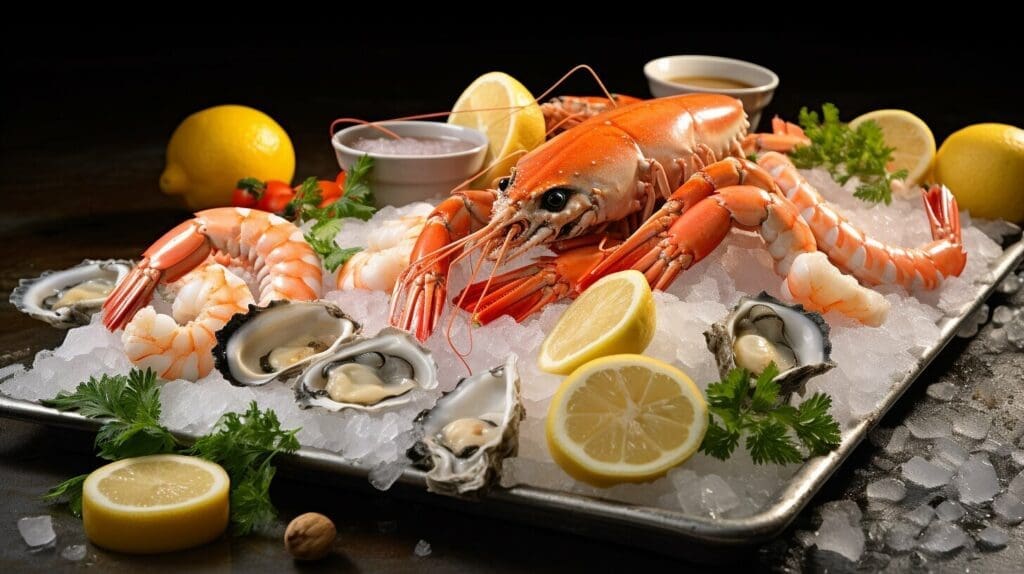
Best Seafood Restaurants in Murrells Inlet
| Restaurant | Description | Signature Dish |
|---|---|---|
| Wicked Tuna | A popular restaurant offering a wide selection of fresh seafood dishes with a modern twist. | Sushi and Seafood Pasta |
| Gulfstream Cafe | Enjoy breathtaking views of the inlet while savoring a variety of seafood options. | Crab Cakes and Shrimp Scampi |
| Dead Dog Saloon | A casual and lively spot with live music and a menu featuring Southern-inspired seafood dishes. | Shrimp and Grits |
Indulging in a delicious meal at one of these restaurants is the perfect way to end your deep sea fishing adventure. Whether you prefer upscale dining or a more laid-back atmosphere, Murrells Inlet has something to suit every palate. So sit back, relax, and savor the flavors of the ocean, knowing that you’ve had a memorable day on the water.
Best Time for Deep Sea Fishing
Planning a deep sea fishing trip? The best time to embark on this thrilling adventure is during the warmer months, specifically between May and September. During this period, the water temperature is higher, creating optimal conditions for catching a variety of fish species.
With the warmer waters, you can expect to encounter a diverse range of fish, including tuna, marlin, mahi-mahi, and more. These months offer prime opportunities to reel in the big catches and experience the excitement of deep sea fishing.
However, it’s important to note that weather conditions can impact the success of your fishing trip. It’s recommended to check the weather forecasts before heading out to sea and plan accordingly. Booking your trip with a knowledgeable and experienced captain can also increase your chances of a successful and enjoyable fishing experience.
| Best Months for Deep Sea Fishing | Water Temperature |
|---|---|
| May | 70°F |
| June | 75°F |
| July | 80°F |
| August | 82°F |
| September | 78°F |
As shown in the table above, the water temperature gradually increases throughout the summer months, reaching its peak in August. This rise in temperature attracts a greater abundance of fish, providing ample opportunities for a successful deep sea fishing experience.
So, if you’re planning a deep sea fishing trip, make sure to schedule it during the warmer months of May to September. With the right timing and a bit of luck, you’ll have an unforgettable adventure filled with thrilling catches and memories to last a lifetime.
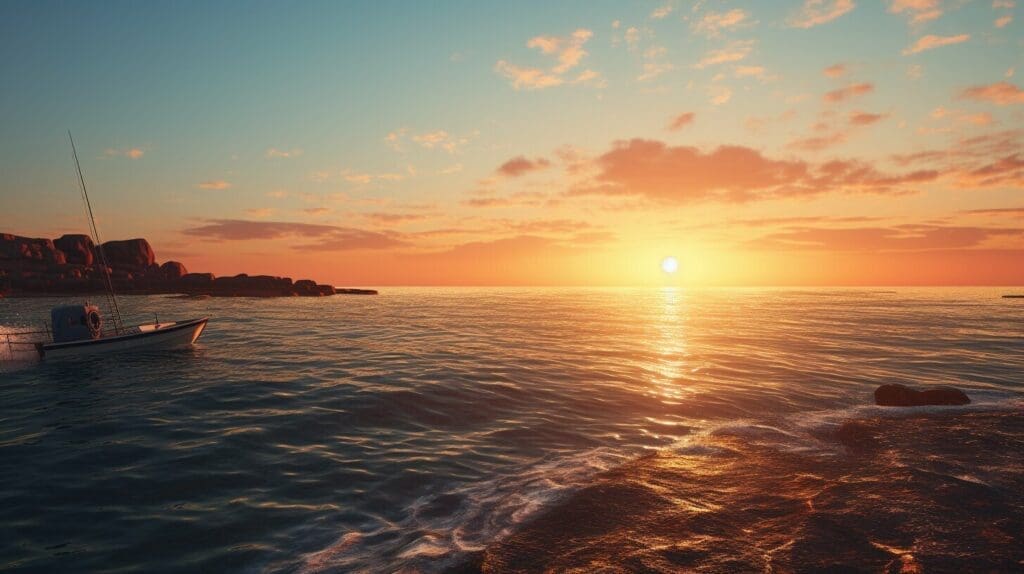
Fishing Limits and Regulations
When it comes to deep sea fishing, it’s important to understand and abide by the limits and regulations in place to protect fish populations and ensure sustainable fishing practices. These rules are crucial for maintaining the health and abundance of marine species for future generations.
Fishing limits dictate the maximum number or size of fish that can be caught, while regulations specify the methods and equipment that can be used. These restrictions aim to prevent overfishing, which can deplete fish populations and disrupt the ecosystem. By adhering to these limits and regulations, we can help maintain a balanced and thriving marine environment.
Additionally, sustainable fishing practices play a crucial role in preserving fish populations. These practices focus on minimizing waste, reducing bycatch (the unintentional capture of non-target species), and using gear and techniques that have minimal impact on the marine ecosystem. By adopting sustainable fishing practices, we can ensure that our activities have a minimal negative impact on the environment and contribute to the long-term abundance of fish species.
Summary:
- Fishing limits and regulations protect fish populations and promote sustainable fishing practices.
- Adhering to limits helps prevent overfishing and maintains a balanced ecosystem.
- Sustainable fishing practices minimize waste and reduce the unintended capture of non-target species.
- By following these rules and adopting sustainable practices, we can contribute to the long-term health and abundance of marine species.
| Type of Regulation | Objective |
|---|---|
| Fishing limits | Prevent overfishing and maintain fish populations |
| Gear restrictions | Minimize environmental impact and reduce bycatch |
| Seasonal closures | Protect spawning grounds and sensitive habitats |
| Size limits | Allow fish to reach reproductive maturity before being harvested |
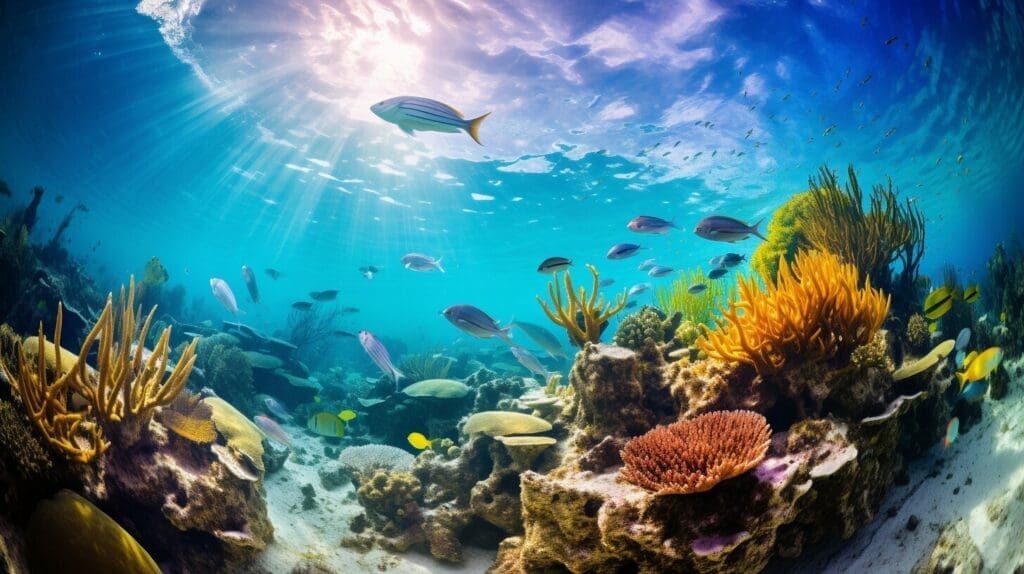
“Sustainable fishing is not just about catching fish responsibly; it’s about ensuring the long-term health and abundance of our oceans and the species that call them home.”
Safety Tips for Deep Sea Fishing
When embarking on a deep sea fishing adventure, it’s crucial to prioritize safety. By following simple guidelines and being prepared, you can ensure a safe and enjoyable experience for yourself and your fellow fishermen. Here are some essential safety tips to keep in mind:
1. Bring the Right Safety Equipment
Before setting sail, make sure you have all the necessary safety equipment on board. This includes life jackets for every person, flares for signaling in case of emergencies, and a first aid kit for any minor injuries that may occur. It’s important to check the condition and expiration dates of these items to ensure they are in proper working order.
2. Check the Weather Conditions
Prior to your fishing trip, always check the weather conditions and sea forecasts for the day. This will help you avoid unexpected storms or rough waters that can jeopardize your safety. If the weather forecast indicates unfavorable conditions, it may be best to reschedule your trip for another day when conditions are more favorable.
3. Listen to the Captain and Crew
The captain and crew of your deep sea fishing charter have the experience and knowledge to keep everyone safe on board. It’s important to listen to their instructions and follow their guidance throughout the trip. They will provide important information on safety procedures, fishing techniques, and any potential hazards to be aware of while at sea.
By prioritizing safety and taking the necessary precautions, you can enjoy the thrill of deep sea fishing while ensuring a safe and memorable experience for everyone involved.
Conclusion
Deep sea fishing is a thrilling adventure that offers the opportunity to explore the vastness of the ocean and experience the excitement of reeling in big catches. Whether you’re an experienced angler or just starting out, deep sea fishing provides a unique and memorable experience.
By choosing top fishing destinations like Murrells Inlet and following the tips and techniques mentioned in this guide, you can increase your chances of success. Booking a deep sea fishing charter is a great way to ensure a well-equipped and guided fishing trip, allowing you to focus on the thrill of the adventure.
Immerse yourself in the beauty of the ocean, experience the adrenaline rush of catching trophy fish, and create unforgettable memories. Deep sea fishing is not just a hobby; it’s an exhilarating journey that will leave you wanting more. So grab your fishing gear, head to a top fishing destination, and get ready for the adventure of a lifetime!
FAQ
What are some popular destinations for deep sea fishing?
Some popular destinations for deep sea fishing include Murrells Inlet, Georgetown Hole, Winyah Scarp, and Black Jack Hole.
What types of fish can I expect to catch in Murrells Inlet?
In Murrells Inlet, you can expect to catch fish like red snapper, grouper, mahi-mahi, tuna, wahoo, and marlin.
What equipment do I need for deep sea fishing?
For deep sea fishing, you’ll need strong and durable rods and reels, high-quality fishing lines, bait and lures specific to the fish species you’re targeting, and a boat or a charter service.
How can I increase my chances of catching a trophy fish?
To increase your chances of catching a trophy fish, use a strong and durable rod and reel, choose a high-quality fishing line, experiment with various baits and lures, and have patience and persistence.
Where can I enjoy fresh seafood after a deep sea fishing trip in Murrells Inlet?
Some restaurants in Murrells Inlet that offer fresh seafood include Wicked Tuna, Gulfstream Cafe, and Dead Dog Saloon.
When is the best time for deep sea fishing?
The best time for deep sea fishing in Murrells Inlet is typically during the warmer months from May to September.
Are there any limits or regulations for deep sea fishing?
Yes, there are limits and regulations in place to protect fish populations and ensure sustainable fishing practices. The exact limits may vary depending on the location and type of fish being caught.
What safety precautions should I take while deep sea fishing?
It’s important to have safety equipment on board, check weather conditions and sea forecasts, and listen to the captain and crew for a safe fishing trip.
What can I expect from a deep sea fishing experience?
Deep sea fishing offers a thrilling adventure, with the opportunity to explore the depths of the ocean and reel in big catches. It provides an unforgettable experience for both experienced anglers and beginners.

